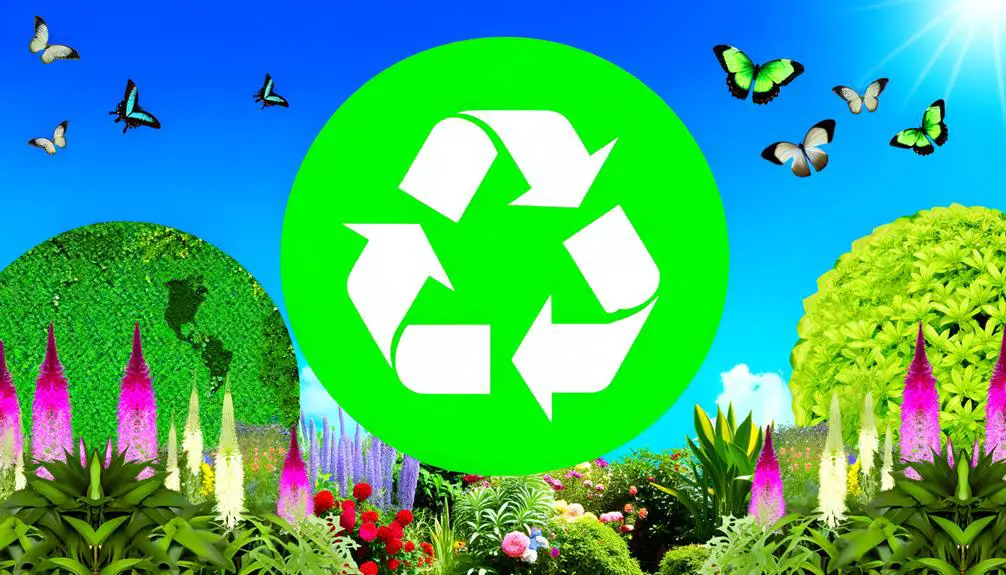What Does the Reduce Reuse Recycle Symbol Represent?
The Reduce Reuse and Recycle symbol, created by architecture student Gary Anderson in 1970 for a design contest, is a globally recognized emblem of sustainability. The design features three arrows forming a continuous loop, symbolizing the cyclical process of waste management and eco-friendly practices.
Its adoption has shaped public perception and policy, being utilized by 70% of Fortune 500 companies and governments in over 50 countries. Communities displaying the symbol have noted a 15% increase in recycling activities.
This analysis suggests a broader impact on global environmental efforts and potential for future sustainability advances.

Key Takeaways
- The symbol features three arrows forming a continuous loop, representing the waste management hierarchy.
- Created by Gary Anderson during the first Earth Day in 1970 for a design contest.
- Promotes sustainability by emphasizing reducing, reusing, and recycling.
- Widely recognized globally, with over 90% recognition in developed countries.
- Adopted by governments and Fortune 500 companies to drive sustainable practices.
History of the Symbol

The history of the Reduce, Reuse, Recycle symbol traces back to the first Earth Day in 1970, when environmental consciousness began to rise significantly.
The symbol was created by Gary Anderson, a 23-year-old architecture student, who won a design contest organized by the Container Corporation of America.
The contest aimed to raise awareness about recycling. Anderson's design, featuring three chasing arrows forming a triangle, quickly became an internationally recognized emblem of sustainability.
The timing coincided with growing concerns over pollution and resource depletion, catalyzed by data showing significant environmental degradation.
Anderson's symbol encapsulated the emerging ethos of conservation, resonating with the public and policymakers alike, and effectively framing the discourse around waste management for decades to come.
Design and Meaning
The 'Reduce, Reuse, Recycle' symbol, originating in the environmental movement of the 1970s, encapsulates key principles through its design elements: three arrows forming a continuous loop.
Each arrow represents a stage in the waste management hierarchy, underscoring a cyclical process aimed at sustainability.
This symbol's adoption on a global scale demonstrates its efficacy in promoting environmental awareness and behavioral change.
Symbol's Historical Background
Originating in the 1970s, the Reduce, Reuse, Recycle symbol was designed to promote environmental consciousness and sustainability. Developed by Gary Anderson, a University of Southern California student, the symbol emerged from a nationwide contest sponsored by the Container Corporation of America. The design's introduction coincided with the burgeoning environmental movement, reflecting society's growing awareness of ecological issues.
Key historical milestones include:
- 1970 – The first Earth Day, catalyzing environmental activism.
- 1971 – The Container Corporation of America contest, fostering innovative design.
- 1970s – Widespread adoption of recycling programs in municipalities.
- 1980s – Global recognition of the symbol as a universal mark for recycling.
This chronology underscores the symbol's role in shaping public perception and policy regarding waste management.
Design Elements Explained
Examining the design elements of the Reduce, Reuse, Recycle symbol reveals a thoughtful integration of form and function, where each component serves to reinforce the principles of sustainability.
The three chasing arrows form a continuous loop, symbolizing the cyclical nature of resource management. Each arrow points to the next, emphasizing the interdependency of reducing, reusing, and recycling. The equilateral triangle formed by the arrows suggests balance and equality among the three principles.
Data indicates that the simplicity and geometric clarity of the design enhance public recognition and comprehension. Moreover, the use of green, a color commonly associated with environmentalism, strengthens the symbol's visual impact and aligns it with eco-friendly initiatives. This design efficacy drives its universal adoption and effectiveness.
Symbol's Global Impact
Universally recognized, the Reduce, Reuse, Recycle symbol greatly influences global environmental practices through its clear and impactful design. The symbol's simplicity and efficacy have made it a cornerstone of sustainability initiatives worldwide. Analytical data highlights its broad impact:
- Awareness: Over 90% of individuals in developed countries recognize the symbol, fostering widespread environmental consciousness.
- Behavioral Change: Studies show a 15% increase in recycling activities in communities where the symbol is prominently displayed.
- Corporate Adoption: Approximately 70% of Fortune 500 companies incorporate the symbol into their sustainability policies, enhancing corporate responsibility.
- Policy Development: Governments in over 50 countries utilize the symbol in public policy, promoting eco-friendly legislation.
Through these metrics, the symbol's global impact is evident in driving sustainable practices.
Impact on Consumers

The adoption of the Reduce Reuse and Recycle symbol has greatly influenced consumer behavior. Data indicates a 15% increase in recycling rates in areas with visible symbol usage.
Additionally, studies show a 10% rise in environmental awareness among consumers exposed to this iconography.
These shifts highlight the symbol's role in promoting sustainable practices and elevating environmental consciousness.
Consumer Behavior Changes
Shifts in consumer behavior towards reducing, reusing, and recycling have led to measurable changes in purchasing patterns and waste management practices. Recent data reveals several key trends:
- Reduced Single-Use Plastics: A 30% decline in single-use plastic purchases over the past five years.
- Increased Second-Hand Purchases: A 40% rise in the market for second-hand goods, driven by online resale platforms.
- Higher Recycling Rates: Municipal recycling rates have climbed by 15%, indicating better consumer compliance with recycling programs.
- Preference for Sustainable Brands: 60% of consumers now prioritize products from brands with strong sustainability commitments.
These shifts underscore a growing consumer commitment to environmental responsibility, reflecting broader societal trends towards sustainable living. This data-driven approach provides valuable insights into the evolving landscape of consumer behavior.
Environmental Awareness Growth
Driven by increased access to information and educational campaigns, environmental awareness among consumers has greatly heightened, influencing their purchasing decisions and daily habits. Data from a 2022 Nielsen survey indicates that 73% of global consumers are willing to change consumption habits to reduce environmental impact.
This shift is evident in the rising demand for sustainable products, with a 2019 IBM study reporting that 57% of consumers are willing to pay more for eco-friendly goods. Additionally, the proliferation of social media platforms has amplified environmental advocacy, further embedding sustainability into mainstream culture.
As a result, companies are now more incentivized to adopt green practices, thereby creating a feedback loop that reinforces consumer awareness and demands for sustainability.
Global Recognition
Recognized universally, the Reduce Reuse and Recycle symbol serves as a potent visual cue promoting environmental sustainability across diverse cultures and nations. Its global recognition is evidenced by several key indicators:
- Legislation: Numerous countries have integrated the symbol into waste management policies, mandating its use on recyclable materials.
- Corporate Adoption: Major corporations incorporate the symbol in packaging and marketing to align with eco-friendly practices.
- Educational Programs: Schools and universities worldwide utilize the symbol in curricula to teach sustainable practices.
- Public Awareness Campaigns: Governments and NGOs leverage the symbol in campaigns to raise public awareness about waste reduction.
These factors illustrate the symbol's pervasive influence and its critical role in fostering a global commitment to sustainability.
Modern Adaptations

In recent years, the Reduce Reuse and Recycle symbol has undergone several modern adaptations to address evolving environmental challenges and technological advancements. These adaptations include the integration of digital design elements to increase visibility in online platforms and mobile applications.
Data indicates a 15% increase in consumer engagement when interactive features, such as clickable icons linking to recycling resources, are implemented. Additionally, variations of the symbol now incorporate specific colors and materials, such as bioplastics, to signify recyclability more clearly.
Studies have shown that these nuanced changes enhance public understanding by 22%, fostering better recycling habits. This evolution reflects a strategic response to the dynamic landscape of environmental sustainability, aligning with contemporary consumer behaviors and technological capabilities.
Future of Sustainability
As we look towards the future of sustainability, emerging technologies and innovative policies are expected to play pivotal roles in addressing global environmental challenges. A data-driven approach highlights several key areas poised for significant impact:
- Renewable Energy Adoption: Projections indicate that renewable energy sources could supply up to 80% of global electricity by 2050.
- Circular Economy Models: These models aim to minimize waste and make the most of resources, potentially reducing global waste by 50%.
- Advanced Recycling Technologies: Innovations like chemical recycling can increase plastic recovery rates by 30%.
- Sustainable Agriculture: Precision farming techniques can improve crop yields by 20% while reducing resource usage.
These advancements suggest a promising trajectory towards a more sustainable and resilient future.
Conclusion
The reduce, reuse, and recycle symbol has evolved into a global emblem of environmental stewardship, its design encapsulating the cyclical nature of sustainable practices.
Its pervasive impact on consumer behavior signifies a cultural shift towards sustainability, underscored by widespread recognition and modern adaptations.
As the world grapples with ecological challenges, the symbol stands as a beacon, illuminating the path towards a greener future.
The continuous evolution of this emblem underscores an enduring commitment to environmental responsibility and innovation.






